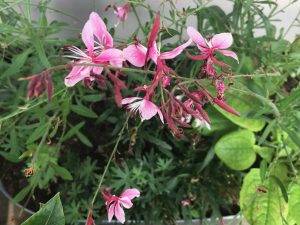
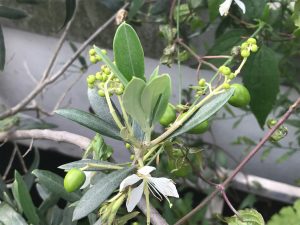
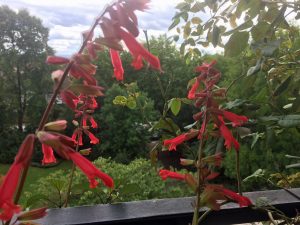

A month or so on, the season has turned and the terrace is in a state of comfortable neglect as floods, holidays and idleness have all played their part. The railings have been interwoven with spider’s webs and the occasional queen wasp spotted making a dash indoors, but the olive trees are much less straggly. Thanks to all the advice I’ve been given I have taken my courage in both hands and cut them back. Already they are providing a better frame to the rest of the terrace, with the anticipated bonus of more wind protection for the rest of the terrace as the growth thickens out.
The Autumn tidy up has begun, and as the leaves of the  surrounding trees first turn then drop, the views and vistas change, and a church spire appears on the brow of the hill with other buildings and permanent structures reemerging in the 270 degree view.
surrounding trees first turn then drop, the views and vistas change, and a church spire appears on the brow of the hill with other buildings and permanent structures reemerging in the 270 degree view.
The necessary further works to ensure no more leaks to the flat below have at last been agreed, but not before some debate and deliberation. The surface of the terrace is part of the demised premises to the property, whilst the walls of the terrace are included in the common parts. However, the actual position of the ‘leak’ is slightly on the rise, precisely I noticed, where one meets the other, and only below the water line in a torrent, for example when a month’s rainfall comes in a day. http://retiringgardener.uk/2017/08/03/out-of-season/ Whilst for me this legal nicety is intriguing, common sense has taken over from any wish to prolong things, and as the surveyor is also back from a summer away, things can move on. Who owns what, who has responsibility for what, who can do what are complexities which are probably best avoided by living in a house with a garden.
Moreover, news has now emerged of major planned works for next year to ensure the integrity of the roofs of the flats below for future years, and therefore the necessity, when the time comes, for all pots, containers, tables and other clutter to be removed to temporary lodgings so that access is fully available. And with this news the answer to a recurring dilemma – how much temporary and seasonal planting to include, and how much to plan for longer term structure and continuity?
For now any new ideas must be transient, as the intention must be, in the overall scheme of things, to reduce the number of permanent planters until the terrace has been renovated next year. The sweet scented box suggested, and which I had already imagined settled in between a beautiful long flowering rose (Rosa Harlow Carr – Aushouse) and a cistus, (Cistus x purpureus) will have to wait. Both rose and cistus have coped happily with a somewhat random regime – the rose being underwatered too often and the cistus being rather brutally uprooted in late Spring from a container where it was competing with too many other plants, then re-potted into a container of its own and finally pruned hard – none of which is recommended. Surprisingly though, it has also flowered all summer long and even now, in this recent Indian summer, looks as though it could, yet again, have another surprise in store.
Meanwhile another impatient hellebore has come into bloom. This is apparently more 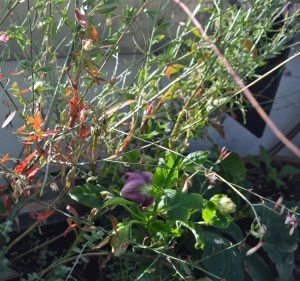 common that I thought but isn’t of interest to the RHS as an example of a rare new species (or do I mean variety?).
common that I thought but isn’t of interest to the RHS as an example of a rare new species (or do I mean variety?).
I have also realised that the requirement to allow full access to the terrace next year is a temporary solution to another problem – when to replace compost, when to top up and how to dispose of it afterwards. Larger quantities of my spent compost usually end up in landfill along with much else, and the nearby recycling centre takes ‘green waste’, but a new project, also dependent on the absence of builders, is to be more effective in taking garden clippings and plants that have gone over, along with the right sort of food waste, to the allotment for composting. This will necessitate taking everything down in the lift, or the long flight of stairs, and across the soon to be laid new communal carpet.
The Naming of Plants
Planting in pots has its delights – moveability being one, so that at different times of the year Spring bulbs, herbaceous plants or one summer wonders like cosmos can look good from the indoors, looking out on wet days, or piled up and around each other to create an illusion of abundance.
But whatever the time of year and the urge to find new ideas, or repeat old delights, high rise gardening in a minute space has its limitations, although these are often worth challenging. With no room and no inclination to propagate, the majority of the plants I choose come from local garden centres, tried and trusted mail order companies, or are gifts from friends. As I am lucky enough to benefit from a family allotment, without doing the digging myself, very occasional forays into planting fruit as well as plenty of herbs, are the closest I get to growing edible produce.
I was promised some wild strawberries plants last week. These have travelled far, having begun their journey in a Romanian forest, then settled well in ano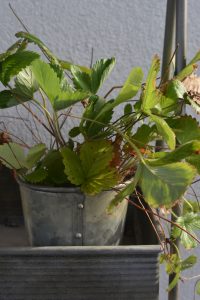 ther corner of the Metropolis where the fruit I’m told has been as tasty as in its original home, but fruit-bearing, surprisingly, for a much longer season. Now arrived and apparently eager to start out again on my windy outcrop, this particularly windy afternoon will be given over to planting and the hope of a crop next year. I consider myself very lucky.
ther corner of the Metropolis where the fruit I’m told has been as tasty as in its original home, but fruit-bearing, surprisingly, for a much longer season. Now arrived and apparently eager to start out again on my windy outcrop, this particularly windy afternoon will be given over to planting and the hope of a crop next year. I consider myself very lucky.
I also tried a blueberry this year. Once upon a time, when living in the West Country, I was rather successful with blueberries in pots. The Spring blossom and striking Autumn tints were lovely and the blueberries were delicious. They never made it to the table as I ate as I gardened, but the milder, damper climate suited them and out in the open they would catch the rain. Now they are more reliant on watering with chalky tap-water and not as happy. More triumphantly, though, one of my olives too produces fruit.
So selecting what to grow is often an exercise in restraint and denial. Never easy. Many of the cottage garden plants I love are either unable to cope with the wind or the restrictions of a container (the clue is in the word) so Japanese anemones which I keep hoping can be persuaded to join the late summer show always protest, and experience has taught me that salvias are happy and penstemon aren’t. Some plants take over and 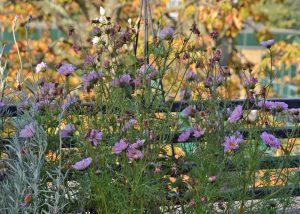 others wilt under the competition, but clematis for all seasons are in their element as I can provide cool roots and allow them to tumble and drift around the railings, whilst being careful to avoid attaching trellis to the walls, cautious as I am about my own injunction to respect the common parts.
others wilt under the competition, but clematis for all seasons are in their element as I can provide cool roots and allow them to tumble and drift around the railings, whilst being careful to avoid attaching trellis to the walls, cautious as I am about my own injunction to respect the common parts.
At school I had Latin lessons, which isn’t quite the same as being taught Latin. Our mistress would arrive, glass of water in hand, cigarette ash on her jacket, and after carefully putting the glass on her desk begin with ‘question number 1’. We were smart enough to include some incorrect answers in the inevitable ten questions that began each lesson, and somehow got away with it at exam time until ‘O’ Levels (no GCSEs in those days) approached, when some observant parents noticed their daughter hadn’t learned anything. At which point the horticulturally named Miss Beechcroft arrived, and with energy and attention instilled enough Latin for us to pass the exam, but of course it was too late for any real learning to take place. The glass of water was gin and we never saw our first teacher again.
All rather sad and a pity, as Latin would now be useful as from time to time I feel interested in the proper names of my small range of plants, although as I am not particularly good at plant names in English this is likely to be an ambition too far. One exception is Sanguisorba officinalis ‘Tanna’ (well actually it is only the Sanguisorba bit of the name that I can remember) but this favourite, and rather unlikely container plant, has gone on for years wafting and waving for weeks on  end. A chance example of what generally does best in my particular conditions – long lasting, forgiving plants without too many dietary or other requirements. Meanwhile an assortment of plant labels sit in an untidy drawer. https://www.claireaustin-hardyplants.co.uk/blog/sanguisorbas
end. A chance example of what generally does best in my particular conditions – long lasting, forgiving plants without too many dietary or other requirements. Meanwhile an assortment of plant labels sit in an untidy drawer. https://www.claireaustin-hardyplants.co.uk/blog/sanguisorbas
Change of View
I notice that gardening experts often suggest occasional soaks rather than little and often when looking after container grown plants, but as my pots struggle with wind and are often overcrowded, I follow the advice of anyone who suggests that you don’t let the compost dry out – well I do let it dry out because life intervenes, but it is not my intention. However, because I am idle and undisciplined in some ways, as well as impulsive, the displays I want always fall short of the displays in my mind – or maybe being idle and impulsive just goes along with the tensions and uncertainties of gardening and gardens, since plants and habitats have habits of their own.
For several years I used to pause to enjoy taking in the delights of a delicate, pink flowered, well established fuschia in another part of London while waiting for the doorbell to be answered. An unexpected return visit this summer happened to be at a time when the fuchsia should have been in full flower, but it had gone, to be replaced by a very smart, formal front garden. I missed the lovely display but if you garden on a very small scale then other people’s gardens and roof-tops are something to seek out and enjoy, albeit with some wistful longings too. As I’ve travelled up and down the District Line this Summer, the emergence of more plants – on terraces, balconies and platforms too, has been very noticeable, but all I can offer the casual passer-by is a glimpse of green, more or less vibrant depending on the season. Modern apartment blocks with clear-sided balconies generously give onlookers an additional view – of pots and plants and new ideas too, as well as the more than occasional bicycle. The sophisticated, tasteful outside spaces often catch my eye, whereas the brightly/garishly coloured plastic balcony pots remind me I’m a snob. A retiring snob you might say, with a traditional roof terrace, brick sided and heavily railed so it is only seen, for the most part, by friendly visitors who can breach my privacy as I wander out at odd moments, in response to something that has caught my eye or would welcome some attention.
And then there are dilemmas I try and ignore.
Early in the summer, and struggling to manage my instincts for informal planting against the need for some structure, I carefully chose and bought two well matched standard lavender plants that once home looked good in my only pair of identical terracotta pots. I placed them against the terrace wall, framing the view up the hill beyond, and carefully ensured that the asymmetrically arranged pots and containers in between, including the much-loved Sanguisorba, looked good together. And they did but I did not stake the lavenders adequately. The winds arrived from all directions, so the tops appeared to spin round while the fragile roots failed to get a grip. In spite of the wind and my particularly inconsistent watering regime, as I became anxious and couldn’t think what was best for them, knowing that better care at the outset would have been best for them, they have struggled on.
One has maintained its upright stance and produced some flower spikes over the summer, flowering again 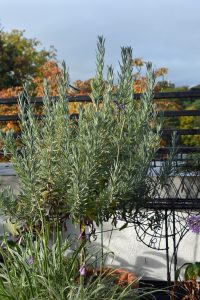 recently, the other never really seemed happy, didn’t produce any flowers, and is trying to escape from it’s managed shape and now seems to be healthier for it. Once again what to do about pruning has bothered me; after flowering, to maintain the shape, to remove dead growth, what? With anxiety came inaction and a new question. Since they are now less of a pair should I relinquish my ambition for identical twins and split them up so they can offer height and interest separately elsewhere.
recently, the other never really seemed happy, didn’t produce any flowers, and is trying to escape from it’s managed shape and now seems to be healthier for it. Once again what to do about pruning has bothered me; after flowering, to maintain the shape, to remove dead growth, what? With anxiety came inaction and a new question. Since they are now less of a pair should I relinquish my ambition for identical twins and split them up so they can offer height and interest separately elsewhere.
Or should I try and reproduce the nurseryman’s original intention and encourage them to match up – having first improved the unsatisfactory staking. This seems the bigger challenge and I might now have the time and inclination to go for it. A fleeting thought that standard bay might be the answer seems a step too far in the direction of formality for this gateway to the woody view, and otherwise suburban, world beyond.